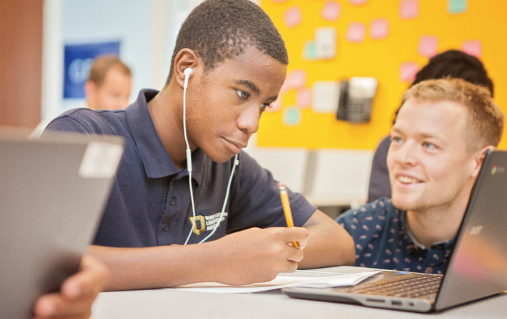More than 500,000 computer science jobs are currently available in every industry and every state, according to Code.org. Given this reality, WLA empowers students to lead the way in computer science to prepare them for college and careers after graduation.
Two hundred dollars. That’s about how much Washington Leadership Academy (WLA) in Washington, D.C. saves every time they need a laptop repaired. Although we’d like to tell you where you could find tech support savings like those, we can’t – they’re not exactly in business, yet.
“Our kids repair their own damaged computers. It was sort of an accidental elective that just became one, because kids started teaching themselves,” said Stacy Kane, the co-founder and executive director of the Washington Leadership Academy (WLA).
WLA’s approach on cultivating student power and agency is hardly accidental, however. It’s woven through every aspect of their school, from educating their students to hiring new teachers and staff, and even to discipline. As a school founded with the goal of using technology to level the playing field for disenfranchised students, WLA has used technology as the springboard for engaging and motivating their students for life beyond high school.

In 2018, all of WLA’s students will take the new AP computer science exam, doubling the number of girls in D.C. taking AP Computer Science, and tripling the number of students of color in D.C. taking AP Computer Science. WLA also gets students out engaging in the real world as much as possible. Each 11th grader will take part in an externship, working for an organization they’re passionate about. Students take anywhere from five to 10 field trips a year, where WLA aims to help them understand the pathway from college to career. WLA has brought in DJs and photographers from the local community for certain electives, where students can learn and interact with the digital tools and professionals who use them.
But as WLA has learned, it’s their students who are leading the way when it comes to learning and teaching tech.
“One our kids surpassed a computer science teacher in developing virtual reality,” said Kane. “So, we empowered that student to teach the class to the rest of the class!”
WLA’s “digital natives,” or kids who don’t remember a time when they didn’t have computers and mobile devices, have challenged their educators to continually pivot, but also guide them, to every resource available to them.
“One of the best things we can do is just teach kids how to find them and let them know it’s available, and then let them fly!” said Kane.
Their students also soar by fulfilling roles within a computer science “staff” of sorts, from computer collection and distribution to taking attendance, a model they wish to mirror in their discipline program. Their eventual aim for their discipline program is that by the students’ senior year, it will be mostly student led.
“We’ve found that when you flip around the power dynamic between the adult and kid, they become really engaged,” said Kane. “They have really good ideas and they like participating more.”
The spirit of participation is echoed in WLA’s recently piloted Restore Lab, where students who have disrupted class meet with the teacher to discuss what happened before they leave for the day. Kane says the face-to-face conversation, where both the teacher and the student can talk about their emotions, has been very effective and has even led to fewer disruptions. They’re working on making the model more systemized and scalable.

WLA is even moving toward student-led parent-teacher conferences and IEP meetings. Student participation is part of hiring new teachers. Students evaluate prospective teachers on a demonstration lesson, and then the teacher candidate can apply it to their second demonstration lesson. It’s led to hiring educators who have the ability to pivot quickly.
“We need people who like to innovate and try new things,” said Kane.
“At WLA, we’re trying to provide the best possible education to our students, and also develop and share innovations that can be used by students, teachers, and schools across the country. The people on our staff are motivated by serving a broader group of people. The days are incredibly long, but we just power through it. We always think about how we can revolutionize education for the kids who need it the most.”
